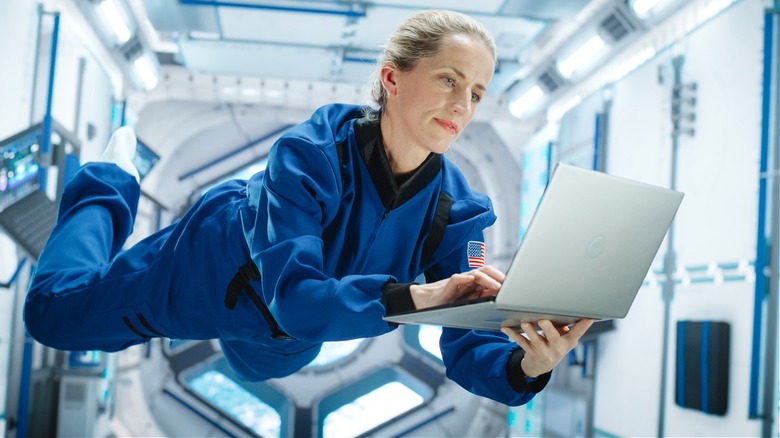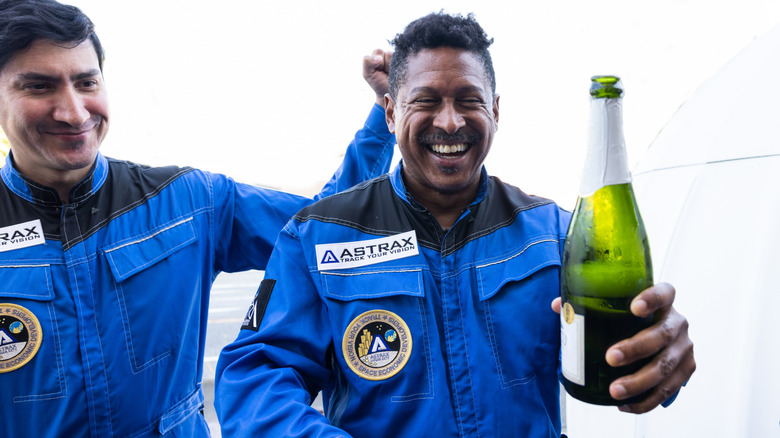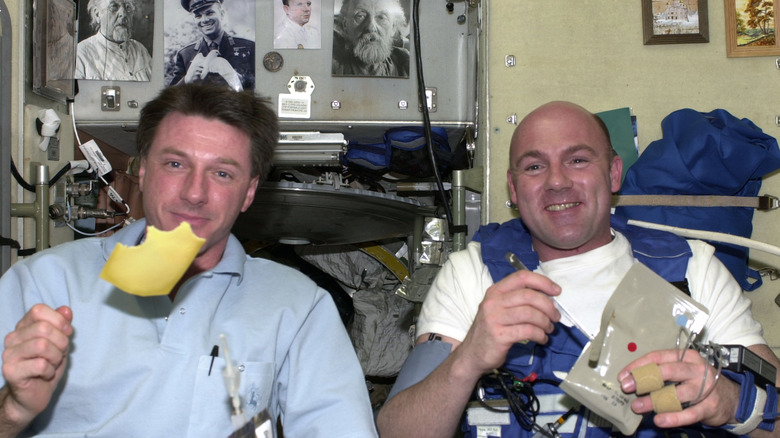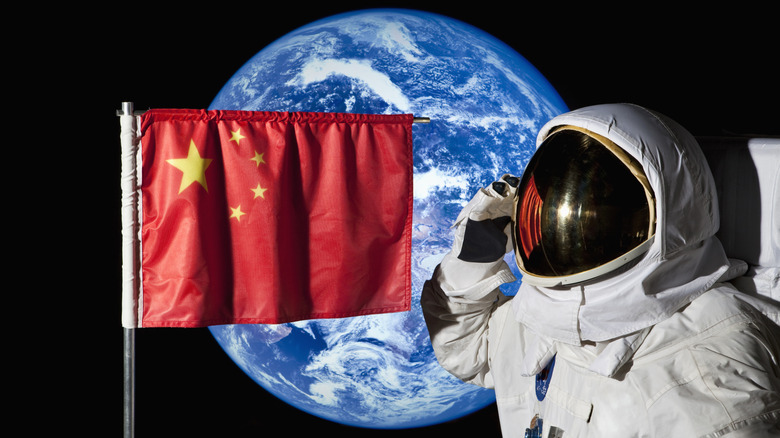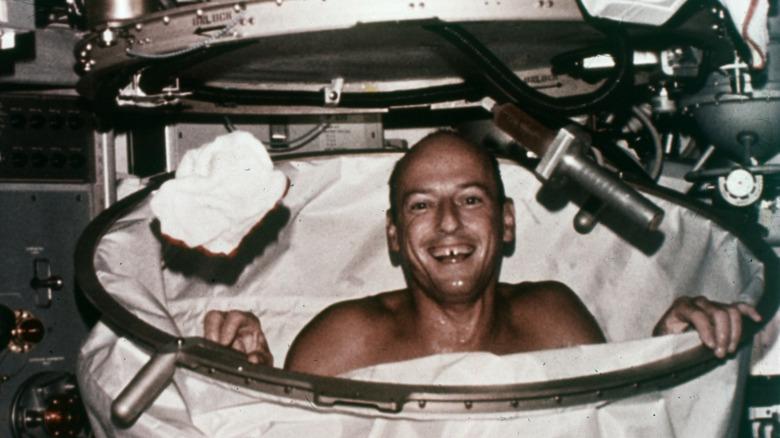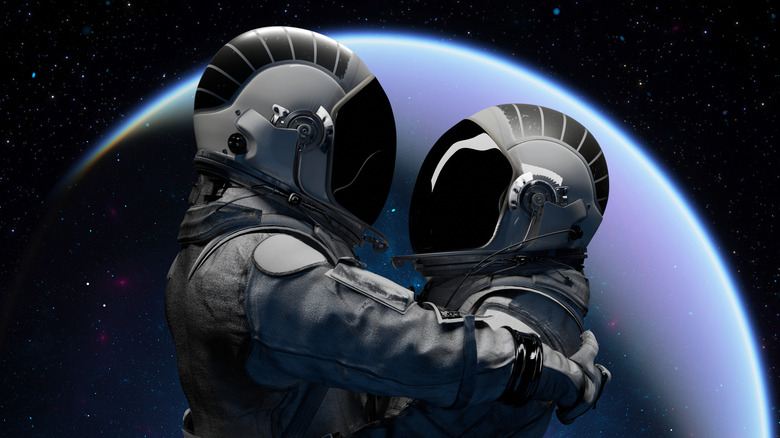5 Activities ISS Astronauts Are Absolutely Banned From Doing
If you've ever dreamed about being an astronaut, it isn't all spacewalks and big-blue-ball views. There's intense training, repeated rejection, rigorous medical exams, and psychological evaluations, to name but a few. Then there's the cruel irony of being told you're not allowed to celebrate your success with a cold beer while putting your feet up and running a watchful gaze over the Earth. In fact, there are many things you're not permitted to do in space, and by extension, the International Space Station (ISS), and they range from the obvious to the oddly specific. They're not all put in place because of safety concerns, either. Politics and plain old practicality are the source of some of them.
The ISS has been continuously occupied for over two decades, and if you look up at the night sky at certain times and under certain conditions, you might catch sight of it. It orbits Earth 16 times a day and passes over 90% of the planet's population. The vast majority of us won't even notice or might even pass it off as an airplane or satellite. However, if you do catch it, instead of filling your heart with wonder about how amazing it must be up there with all that peace and tranquility, spare a thought for the poor astronauts who must follow a rigid set of rules and regulations — many of which you probably never realized. Here are five activities that are big no-nos on the ISS.
Drinking Alcohol
Alcohol is completely banned on the International Space Station, but not for the reasons you might think. Before you imagine astronauts chugging on beers, smashing whiskey, and getting rowdy on multi-billion dollar infrastructure, the real reason for the ban is simple: it can damage the station's water recovery system. That means it's not just Jim Beam, Johnnie Walker, jungle juice, and jello shots that are banned; everyday items containing alcohol, like mouthwash and aftershave, are also prohibited.
That's because ethanol evaporates faster than water, so just opening a bottle releases fumes into the air. This threatens the filtration system that recycles all that sweat, breath, and urine back into drinking water. Aside from that, the public may not feel too reassured knowing NASA's astronauts are not fully cognitive when whizzing around up there at 17,500 mph (which is just one interesting fact about the ISS). Alcohol consumption is banned a full 12 hours before their flight has even launched.
There is also the cultural minefield that could flare up social tensions with non-drinking astronauts who could be religious abstainers or teetotalers. It's a landmine that NASA would prefer to avoid altogether, and despite stories of unofficial consumption and NASA testing alcohol in space for scientific purposes, there has been no official story of ISS inhabitants breaking the rules as of yet. Anyway, with zero gravity messing with stomachs, the result would likely be wet burps (or worse) floating around in microgravity, something that even the boldest beer-loving astronaut should never experience.
Consuming certain foods and drinks
Unlike on Earth, gas bubbles don't separate from liquids in microgravity. So if you consume carbonated drinks on the ISS, both are expelled together. In other words: wet burps. Therefore, along with beer, soda is also prohibited. But it's not just fizzy beverages. Many food items are out of the question, too. Bread is forbidden because crumbs can easily break off and float, which can damage equipment or even end up in astronauts' eyes.
Those crumbs are labeled as Foreign Object Debris (FOD), which is basically unwanted loose particles, materials, or small objects that pose a physical threat to equipment, systems, or personnel. Who would have thought crumbs could be so threatening? In 1985, tortillas started making their way to space because they don't produce those menacing crumbs that break off, float around, and unleash terror on unsuspecting astronauts. In space, no one can hear you scream, so ISS residents make do with tortilla sandwiches instead.
Salt and pepper, or any powdered spice for that matter, are also FODs. Who would want to be that astronaut that foolishly sprinkles chili powder on their space munchies in microgravity? However, space food isn't totally bland; liquid salt and pepper (in oil) spruce up dishes via squeeze bottles. With no freezer on the ISS, cold treats like ice cream are also a problem. Freeze-dried ice cream is too brittle and can create those frightening FOD flakes, although regular ice cream is sometimes delivered in freezers primarily used for returning scientific samples. However, it must be eaten immediately, but then what ice cream isn't?
Inviting the Chinese neighbors over
If you've seen the movie "Gravity," you may have been surprised by how relatively easy it was for Sandra Bullock to get from the ISS to Tiangong, the Chinese space station. However, in reality, it would never have been that easy, as the two stations were located in different orbits, which meant transfer between them was impossible without significant orbital adjustments. The movie changed their positions for easier storytelling, so even if you were an astronaut with the grand idea of inviting the Chinese neighbors over for some green tea, you couldn't. But then even if you could, you still couldn't.
That's because all Chinese personnel have been banned from the ISS since 2011, when Congress passed a law prohibiting official American contact with the Chinese space program. This was due to national security concerns, and according to a US-Chinese Economic Security Review Commission report from 2012, the law is justified due to the Middle Kingdom seeing strong space capabilities as a way to compete with other nations in overall power and influence. Other reports backed it up, but since then, the Tiangong space station has burned up, and new ones have been up and down like a yo-yo. Yet the ban remains — which is a real pity, as that green tea invite could have possibly worked out in much the same way as ping pong diplomacy did way back in 1971.
Showering
Traditional showers are banned on the ISS. In fact, they are impossible. In microgravity, water and soap stick to everything, which makes all the joys of Earth-bound showering, from lathering to rinsing, out of the question. On Gemini and Apollo missions, astronauts used sponge baths with a towel and soap, but water was extremely limited. Needless to say, on their return to Earth, they were emitting some serious space funk. On the Skylab experimental space station, astronauts had a tube-like shower where they had to have their feet strapped down and used a pressurized bottle along with a fireproof curtain to contain the water. The drain used a vacuum system to pull the liquids from the shower floor, and it took astronauts around two hours to get clean because all the excess had to be suctioned into a collection bin.
On the ISS, NASA has returned to the sponge bath approach but with a few tweaks that ensure the station's inhabitants don't have that distinctive space stench that Gemini and Apollo astronauts had. With liquid soap and water from pouches applied directly to their skin in combination with rinseless shampoo wiped off with towels, the space agency has found a way to defy the laws of space hygiene. An airflow system then evaporates all remaining moisture for recycling. These sponge baths save on water, space, and weight compared to a full shower system, and the crew members now radiate with cosmic cleanliness. It's just one of the ways how astronauts perform basic everyday tasks on the ISS. However, it's understandable that they still miss that feeling of water falling on their skin. And on return to Earth, there have been reports of them jumping fully clothed into pools or dancing around in the rain.
Getting it on
Sex is banned partly because of the risks a pregnant astronaut could pose, including putting a strain on resources like food, oxygen, and medical supplies. NASA's stance is that no human has ever joined the 250-mile-high club. However, there is plenty of speculation to the contrary. Unofficial stories persist of a Mir station romance between cosmonaut Valery Polyakov and astronaut Elena Kondakova. All allegations have been refuted, though the cosmonaut did write down steamy desires in his diary (well, he did spend a long time up there). He also wrote an astronomically ridiculous story about how his superiors put forward the proposal of a sex doll to practice docking procedures with.
But by 1992, the no-sex rule remained an unwritten one. That was, however, until the secretly married couple Mark Lee and Jan Davis went to space together. NASA soon set the law in stone, and since then, it hasn't done much, if any, research into space sex or reproduction, which doesn't really make sense considering we are supposed to be looking at colonizing Mars. In fact, an internal NASA report once suggested an all-female Mars crew to ensure no onboard nookie. Obviously the genius behind that report never considered same-sex relations.
However, there are physical and biological challenges to overcome if shenanigans in the stars are ever to become normal practice. First of all, and apologies for the imagery, all bodily fluids would float around or stick to surfaces in the cabin. Then there is the fact that every movement would push partners apart, so astronauts would need to be anchored somehow. Of greater significance, there are the more serious aspects of reproduction and pregnancy health, with possible impacts ranging from hormonal changes to developmental issues, making that NASA space sex research all the more vital.
